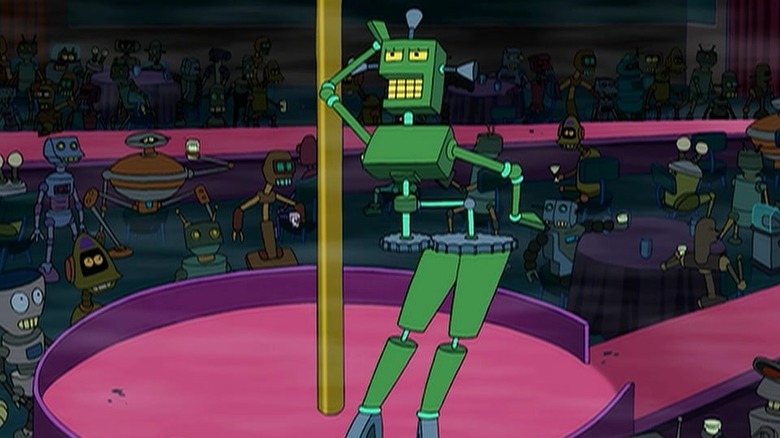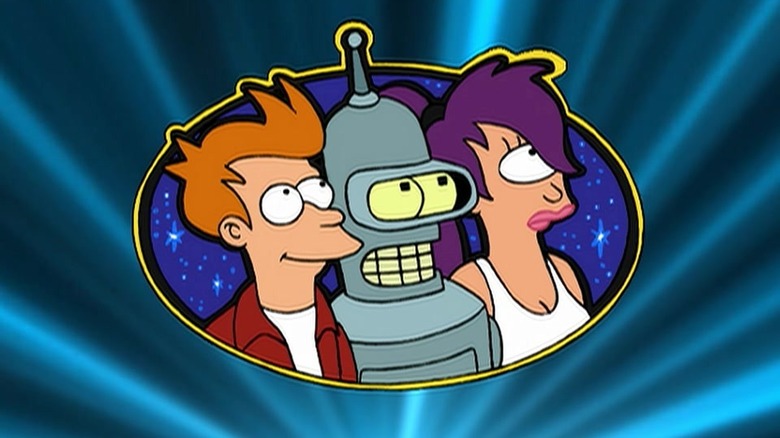Please note, we might earn a commission from purchases made via our links.
20th Television
Back in 1990, during the second season of “The Simpsons,” the show’s creator, Matt Groening, started brainstorming for a new series. He envisioned a show that would parallel “The Simpsons” in the same way “The Jetsons” did for “The Flintstones.” Groening took several years to refine his ideas, and eventually, he brought “Simpsons” writer David X. Cohen on board to co-create the show. Together, they crafted a world set in A.D. 3000, populated by a diverse cast of characters, robots, and aliens. The show, tentatively titled “Aloha, Mars!” or “Doomsville,” was initially much darker, featuring a dystopian society with suicide booths at every corner.
After much tweaking, Groening and Cohen launched “Futurama” on March 28, 1999. The characters were modeled after Groening’s designs, and animated in his distinctive style. However, unlike “The Simpsons,” “Futurama” characters had realistic skin tones. Groening and Cohen often mentioned in DVD commentaries that “The Simpsons” was a fictional sitcom, but “Futurama” was based in reality.
In the introduction to the book “The Art of Futurama,” Cohen confessed that his artistic skills were not his strong suit. He preferred to focus on storytelling, character development, and intricate math jokes. His drawing skills were rudimentary at best, but he was able to contribute one significant design to the show: a robot stripper.
David X. Cohen’s Contribution to Futurama’s Design

20th Television
The robot stripper debuted in the episode “The Lesser of Two Evils” (February 20, 2000), where Bender (John DiMaggio) found a robot look-alike named Flexo. The two robots, sharing the same vices, decided to unwind at Electric Ladyland, a robot strip club. The club offered a glimpse into what robot strippers of the future looked like, including one that performed a fan dance with electric fans for hands.
The robot stripper that Cohen designed featured a stationary upper body and gyrating hips, creating a mechanically enticing dance. Even with his limited artistic skills, Cohen was able to effectively design the robot stripper, which was mostly cubical in shape. He said:
“My design skills are best suited for abstract ideals. I excel at drawing squares and cubes. The one and only character I designed for ‘Futurama’ was a gear-based robot dancer at Bender’s favorite robot strip club. This is right up my alley! The joke is based on the character embodying the pure concept of a gyrating hip gear, from mathematical model to page.”
The other robot strippers and the robots in the audience were designed by Groening or other members of the creative team.
Cohen’s Influence on Futurama’s Design

20th Television
Cohen confessed that while he lacked drawing skills, he was adept at directing other talented artists to create the designs he envisioned. He quipped, “They have to listen to me!” Because he didn’t do the drawing himself, he could provide vague descriptions, and his team would interpret them accordingly. He said:
“The setup works better than you might think. I have no choice but to express myself in terms of feelings and adjectives. Can that space boat be more dilapidated? Can Zoidberg’s pants be more dismal? Can Kif’s planet be mushier? I don’t provide many specifics on how to achieve these results, because I can’t! This gives the artists a lot of freedom. And on their own, they consistently produce stunning results. I honestly don’t know how they do it. It’s like everything is a cube to them!”
“Futurama” has been on the air intermittently for the past 25 years, and its designers have consistently produced outstanding work. Some designs are intentionally simple — for instance, Bender is just a trashcan shape — but the artists have also created intricate backgrounds and aliens within Groening’s style limits.
As for the robot strippers, they frequently appear on “Futurama.” Notably, Fanny (Tress MacNeille), the wife of the Don Bot (Maurice LaMarche), was featured in “Into the Wild Green Yonder.” But don’t ask how or why robots have sex on “Futurama.” That’s a mystery that remains unsolved.
Conclusion
In conclusion, David X. Cohen’s contribution to “Futurama” extends beyond his writing skills. Despite his self-professed limited artistic ability, he designed a memorable character – the robot stripper. Moreover, his ability to guide other artists and communicate his vision effectively has led to the creation of a unique and captivating world that has entertained audiences for over two decades.
FAQs
Who created Futurama?
“Futurama” was co-created by Matt Groening, the creator of “The Simpsons,” and David X. Cohen, a writer from the same show.
What was unique about the characters in Futurama?
Unlike “The Simpsons,” the characters in “Futurama” had realistic skin tones. The creators often mentioned that while “The Simpsons” was a fictional sitcom, “Futurama” was set in reality.
Who designed the robot stripper in Futurama?
The robot stripper in “Futurama” was designed by David X. Cohen, one of the show’s creators.
How does Cohen contribute to the design process in Futurama?
Although Cohen does not draw, he provides direction and input to the artists on the show, using broad descriptions and emotions to guide their designs.
Credit: www.slashfilm.com


